
Crinoids are marine invertebrates that make up the class Crinoidea. Crinoids that remain attached to the sea floor by a stalk in their adult form are commonly called sea lilies, while the unstalked forms, called feather stars or comatulids, are members of the largest crinoid order, Comatulida. Crinoids are echinoderms in the phylum Echinodermata, which also includes the starfish, brittle stars, sea urchins and sea cucumbers. They live in both shallow water and in depths over 9,000 metres (30,000 ft).
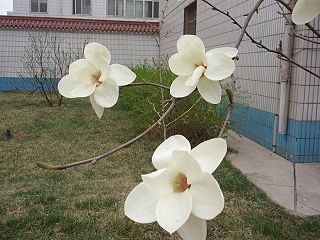
Magnoliopsida is a valid botanical name for a class of flowering plants. By definition the class will include the family Magnoliaceae, but its circumscription can otherwise vary, being more inclusive or less inclusive depending upon the classification system being discussed.

The Myctophiformes are an order of ray-finned fishes consisting of two families of deep-sea marine fish, most notably the highly abundant lanternfishes (Myctophidae). The blackchins (Neoscopelidae) contain six species in three genera, while the bulk of the family belongs to the Myctophidae, with over 30 genera and some 252 species.
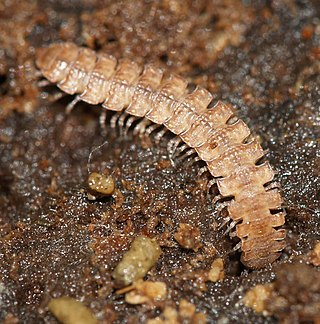
Chilognatha is a subclass of the class Diplopoda, which includes the vast majority of extant millipedes, about 12,000 species.

Dictyoptera is an insect superorder that includes two extant orders of polyneopterous insects: the order Blattodea and the order Mantodea (mantises). All modern Dictyoptera have short ovipositors and typically lay oothecae. The oldest fossils of Dictyoptera from the Late Carboniferous, referred to as "roachoids" have long ovipositors and did not lay oothecae. The oldest modern oothecae-laying dictyopterans date to the Late Triassic.

Caenogastropoda is a taxonomic subclass of molluscs in the class Gastropoda. It is a large diverse group which are mostly sea snails and other marine gastropod mollusks, but also includes some freshwater snails and some land snails. The subclass is the most diverse and ecologically successful of the gastropods.

The Batrachomorpha are a clade containing extant and extinct amphibians that are more closely related to modern amphibians than they are to mammals and reptiles. According to many analyses they include the extinct Temnospondyli; some show that they include the Lepospondyli instead. The name traditionally indicated a more limited group.

Laurasiatheria is a superorder of placental mammals that groups together true insectivores (eulipotyphlans), bats (chiropterans), carnivorans, pangolins (pholidotes), even-toed ungulates (artiodactyls), odd-toed ungulates (perissodactyls), and all their extinct relatives. From systematics and phylogenetic perspectives, it is subdivided into order Eulipotyphla and clade Scrotifera. It is a sister group to Euarchontoglires with which it forms the magnorder Boreoeutheria. Laurasiatheria was discovered on the basis of the similar gene sequences shared by the mammals belonging to it; no anatomical features have yet been found that unite the group, although a few have been suggested such as a small coracoid process, a simplified hindgut, high intelligence, lack of grasping hands and allantoic vessels that are large to moderate in size. The Laurasiatheria clade is based on DNA sequence analyses and retrotransposon presence/absence data. The superorder originated on the northern supercontinent of Laurasia, after it split from Gondwana when Pangaea broke up. Its last common ancestor is supposed to have lived between ca. 76 to 90 million years ago.
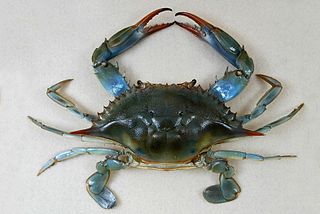
Eumalacostraca is a subclass of crustaceans, containing almost all living malacostracans, or about 40,000 described species. The remaining subclasses are the Phyllocarida and possibly the Hoplocarida. Eumalacostracans have 19 segments. This arrangement is known as the "caridoid facies", a term coined by William Thomas Calman in 1909. The thoracic limbs are jointed and used for swimming or walking. The common ancestor is thought to have had a carapace, and most living species possess one, but it has been lost in some subgroups.

In plant taxonomy, commelinids is a clade of flowering plants within the monocots, distinguished by having cell walls containing ferulic acid.

Parasitiformes are a superorder of Arachnids, constituting one of the two major groups of mites, alongside Acariformes. Parasitiformes has, at times, been classified at the rank of order or suborder.

Crocodylomorpha is a group of pseudosuchian archosaurs that includes the crocodilians and their extinct relatives. They were the only members of Pseudosuchia to survive the end-Triassic extinction. Extinct crocodylomorphs were considerably more ecologically diverse than modern crocodillians. The earliest and most primitive crocodylomorphs are represented by "sphenosuchians", a paraphyletic assemblage containing small-bodied, slender forms with elongated limbs that walked upright, which represents the ancestral morphology of Crocodylomorpha. These forms persisted until the end of the Jurassic. During the Jurassic, crocodylomorphs morphologically diversified into numerous niches, with the subgroups Neosuchia and the extinct Thalattosuchia adapting to aquatic life, while some terrestrial groups adopted herbivorous and omnivorous lifestyles. Terrestrial crocodylomorphs would continue to co-exist alongside aquatic forms until becoming extinct during the Miocene.
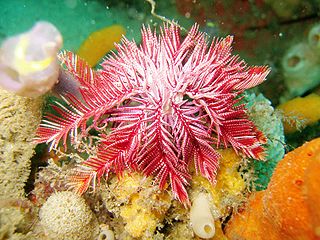
Articulata are a subclass or superorder within the class Crinoidea, including all living crinoid species. They are commonly known as sea lilies or feather stars. The Articulata are differentiated from the extinct subclasses by their lack of an anal plate in the adult stage and the presence of an entoneural system. Articulata first appeared in the fossil record during the Triassic period although other, now extinct crinoid groups, originated in the Ordovician.

Eleutherozoa is a subphylum of echinoderms. They are mobile animals with the mouth directed towards the substrate. They usually have a madreporite, tube feet, and moveable spines of some sort. It includes all living echinoderms except for crinoids. The monophyly of Eleutherozoa has been proven sufficiently well to be considered "uncontroversial."

Orthoceratoidea is a major subclass of nautiloid cephalopods. Members of this subclass usually have orthoconic (straight) to slightly cyrtoconic (curved) shells, and central to subcentral siphuncles which may bear internal deposits. Orthoceratoids are also characterized by dorsomyarian muscle scars, extensive cameral deposits, and calciosiphonate connecting rings with a porous and calcitic inner layer.

Rhynchonelliformea is a major subphylum and clade of brachiopods. It is roughly equivalent to the former class Articulata, which was used previously in brachiopod taxonomy up until the 1990s. These so-called articulated brachiopods have many anatomical differences relative to "inarticulate" brachiopods of the subphyla Linguliformea and Craniformea. Articulates have hard calcium carbonate shells with tongue-and-groove hinge articulations and separate sets of simple opening and closing muscles.

The Camerata or camerate crinoids are an extinct subclass of Paleozoic stalked crinoids. They were some of the earliest crinoids to originate during the Early Ordovician, reached their maximum diversity during the Mississippian, and became extinct during the Permian–Triassic extinction event. Camerates are the sister group of Pentacrinoidea, which contains all other crinoids. The two largest camerate subgroups are the orders Diplobathrida and Monobathrida.
Disparida is an parvclass of extinct marine animals in the class Crinoidea. Disparids are a speciose and morphologically diverse group of crinoids distinguished by their monocyclic calyx and slender arms without pinnules. They range from the Early Ordovician (Tremadocian) to Middle Permian, reaching their highest diversity during the Late Ordovician.
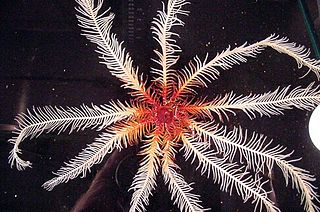
Pentacrinoidea is a subclass of crinoids containing all members of Crinoidea except for the exclusively Paleozoic camerates. It was originally named in 1918 by Otto Jaekel, who hypothesized a fundamental split between camerate and non-camerate crinoids. Later workers doubted this interpretation, and Pentacrinoidea was rarely used during the rest of the 20th century. Recent phylogenetic work has provided strong support for Jaekel's hypothesis, and Pentacrinoidea was reinstated in a 2017 revision of crinoid systematics.

Flexibilia is a superorder of specialized Paleozoic crinoids. They exhibited a conserved body plan and consistent suite of characteristics throughout their long history. Previously considered a subclass with unclear affinities, later investigation determined that flexibles are well-nested within Cladida, a broad group ancestral to living articulate crinoids. The Ordovician cladid Cupulocrinus acts as an intermediate form linking the generalized anatomy of other early cladids with the distinctive anatomy of flexibles, and several studies have considered it to be ancestral to the rest of the group. Although flexibles never reached the same abundance or diversity as many other crinoid groups, they remained a reliable component of crinoid faunas, particularly from the Silurian onwards. Flexible fossils are very rare in the Ordovician, but the Late Ordovician appears to have been an interval of rapid diversification for the group.



















